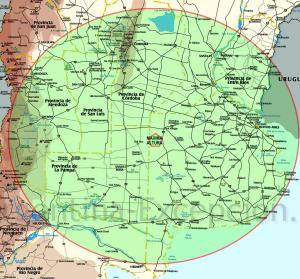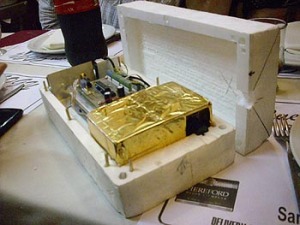The 145.850 MHz SSTV ROBOT-36 mode images will be transmitted in real time showing the view from the balloon. The images can be displayed by using free software such as MMSSTV.
Since 145.850 MHz is the input frequency for the amateur radio satellite SO-50, part of the experiment will be a link between the balloon and the satellite with SO-50 retransmitting the SSTV images on 436.7950 MHz over a far wider area.
At an altitude of 30 km the FM repeater, which uses a 123 Hz CTCSS tone, could have a range of up to 750 km.
AMSAT-LU have issued the following announcement:
AMSAT Argentina is pleased to announce that on Saturday, March 23, 2013 from 14hs GMT climate permits, launch of free balloon repeater ‘Betty’ is planned from near Castex, La Pampa, 660 km. west of Buenos Aires. Details and photos of the announcement and prior experience in http://www.amsat.org.ar/globo23.htm
Approval of ANAC (Civil Aviation National Administration (Argentina FAA)) had been granted. http://amsat.org.ar/images/anacfax.jpg .
For these experiments members of AMSAT-LU, LUSEX, project development group http://lusex.org.ar , are working together with Pampeano amateur Radio Club, RC QRM Belgrano, APRS Group, etc.
The electronics is comprised of a voice UHF to VHF FM repeater with CW TLM, APRS, DTMF and SSTV. According to estimates balloon could reach over 30,000 meters high, traveling for 3 hours, 100 km to the east of the launch site.
 This would allow contacts between stations located in the provinces of Buenos Aires, Santa Fe, Entre Rios, Cordoba, Catamarca, Santiago del Estero, La Pampa, San Luis, Mendoza, San Juan, Rio Negro, Neuquen, Uruguay and Chile. (It is launched from the center of the country to facilitate greater participation). Details http://www.amsat.org.ar/picocubr.jpg
This would allow contacts between stations located in the provinces of Buenos Aires, Santa Fe, Entre Rios, Cordoba, Catamarca, Santiago del Estero, La Pampa, San Luis, Mendoza, San Juan, Rio Negro, Neuquen, Uruguay and Chile. (It is launched from the center of the country to facilitate greater participation). Details http://www.amsat.org.ar/picocubr.jpgTo receive the payload, if less than 750 km from the launch site, only need is a handy or base FM receiver on 145.950 KHz for voice, 144,930 for APRS or 145.850 for SSTV.
The repeater which is enabled via 123 Hz CTCSS subtone, receives 435.950 MHz FM voice (-112dBm, 0.56 uV) emitting 2W output simultaneously on 145.950 MHz.
To enable better utilization, it is suggested short QSOs (license, own locality, grid locator, received signal and short comments).
Simultaneous emits APRS 1200 baud at 144,930, and also in 145,950. The DTI symbol on APRS will change from a balloon ( /O ) during ascent to a slider ( /g ) during the parachute descent.
Will operate for 90 seconds voice, then a beep alerting the end of that time will make way for the issuance of APRS at different frequencies. Every five minutes CW TLM via telegraphy audio tones sends callsign LU7AA and height in meters, then repeat the cycle.
On 145.850 MHz SSTV images ROBOT-36 mode (36 seconds) will be emitted in real time continuously showing what the balloon sees (Can be received, with either MIXW or RX-SSTV (recommended)).
Given 145.850 MHz could be received by SO-50, part of experiment will be crosslink between balloon and SO-50 during his three timeframe passes, thus allowing SSTV from Balloon -> 145.850 -> SO-50 -> 432.795 -> user, providing a wider footprint.
Balloon will carry two TV cameras (one to ground and another to the horizon) that will record images and sound during flight and can be retrieved with the payload.
It can be received in APRS on http://aprs.fi/?call=lu7aa-11 every minute, including speed, height, internal and external temperatures and battery voltage.
Georeferenced maps are available for UI-View in http://www.amsat.org.ar/pico.jpg, http://www.amsat.org.ar/pico.txt.
The experiment on 435.950 MHz voice also receives and accepts DTMF user issued commands i.e. B * (DTMF keypad UHF handy) will return S5 … ….. on VHF CW 145.950, your signal strength received at balloon, if P10 that states S9 +10. There are more commands that enable issuance of TLM in CW or APRS beacon and remote commands to drop payload, mode changes, control of time, energy, power, etc..
Additionally and in coordination with ANAC, a VAISALA RS92SGP radiosonde emitting FM wide on 402-403 Mhz has been added, which provides GPS location, pressure, winds, height, course, dwt point, temperatures, etc. Same data as daily collected by the National Meteorological Service. Data can be received with sondemonitor program available as test for 21 days from internet.
On launch day/time AMSAT-LU will have one of his members on the Ezeiza Airport Traffic Tower, acting as a contact between ANAC and AMSAT, using VOR locations application gently configured by EOSS, adapted and available on http://amsat.org.ar/vor.asp .
Local frequencies coordination and announcements before and during flights will be 7095 kHz LSB + / -10 kHz and VHF frequencies of local repeaters in the area.
During flight will be active in 430.930 and 144.930 the AMSAT-LU APRS wide coverage Igate LU7AA-0, operating from the Investigation Center, besides a portable Igate close to launch site. Any area stations that can receive and provide bridge to the APRS network are welcome.
Being an experiment aimed at a next satellite, contacts made between stations thru this UV repeater will be considered valid and awarded upon request by Amsat-LU Permanent Satellite Certificate, free and also applicable for license upgrades, see http://www.amsat.org.ar/certsat.html, http://www.lu4ao.org.ar, http://www.amsat.org.ar/lu4aao.
During the balloon flight, chase hunt groups will try to locate and recover the payload estimated to land next to General Pico, La Pampa.
The 10 participants with the highest two-way contacts numbers and sum of distances thru repeater will be recognized with a special certificate. Send email with data filled on form http://www.amsat.org.ar/lu4aao/Globo_23mar2013.xls QSO with stations via the balloon including QRA Locators, QTR to Radio Club QRM Belgrano before April 23.
All reports welcome. If you want or can organize or be part of launch teams, control, monitoring and recovery, operating as an independent station and capturing data, and / or want to join us in this adventure from the launch site can do it through an email to parapente arroba amsat.org.ar.
Please forward this information if possible.
73, LU7AA, AMSAT-LU, aiming to the future by making present fun.
http://www.amsat.org.ar/
http://amsat-uk.org/2013/03/15/amsat-lu-to-launch-amateur-radio-fm-repeater-to-an-altitude-of-30-km/









No comments:
Post a Comment